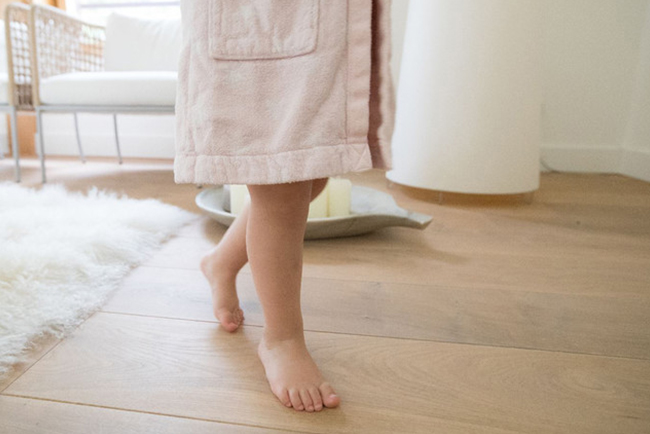Barefoot through the cold season
Bonded floor coverings are ideal on underfloor heating
Summer just flew by and soon autumn will be knocking at the door accompanied by cooler temperatures. Leaving the warmth of your bed in the morning and stepping barefoot on the freezing cold bedroom or bathroom floor is not a good start to the day. But it doesn’t have to be that way. Underfloor heating systems offer cosy warmth and comfort that allows residents to walk around barefoot in all seasons. Even the ancient Romans appreciated the benefits of a “hypocaust” or heated floor. In Germany, underfloor heating has become increasingly popular since the 1970s.
Cosy warmth is by no means the only advantage of underfloor heating. Without radiators on the walls, the interior of the room can be designed and furnished much more freely. At the same time, the room requires less heating since the heat is radiated evenly from below and reflected by walls and ceilings. At around 35 degrees Celsius, the flow temperature of underfloor heating systems is also lower than that of classic radiators. This saves energy and thus heating costs.
The flooring materials of choice on underfloor heating are ceramic tiles and natural stone. They feature excellent heat storage capacity and thermal conductivity. With parquet floors, the right choice of wood is important: oak and walnut are best suited for conducting heat. However, small parquet strips are recommended since wood expands under the influence of heat and tends to form joints. Finished parquet is therefore best suited. But also carpet, PVC, laminate and cork can be installed on top of underfloor heating systems if this use has been approved by the respective manufacturer. It is advisable to have the floor covering bonded over its entire surface by a professional floorer instead of choosing loose lay or floating installation. In the case of full-bond installation, no separating air layer can form between flooring and substrate. This not only allows the heat to enter the room more quickly and efficiently, but also significantly reduces the footfall sound.
A further plus: The absence of radiators means that no dust is whirled up. The dry floor heat inhibits the growth of house dust mites and also prevents the formation of mold. Floor heating systems are therefore more hygienic. Two thirds of the emitted heat is radiant heat – this also improves the indoor air quality. The result: Even more comfort and a better climate – especially for allergy sufferers.
To ensure a sustainable and healthy home, only low-emission products should be used for bonding the floor covering. The EMICODE® label provides the necessary guidance. The prestigious award is only granted to manufacturers whose products have been proven to be low in emissions. The strict EMICODE® limits are the result of continuous product testing by independent experts. This ensures that rooms with underfloor heating not only stay warm, but also free of harmful substances for many years to come.

Photo: ©GEV
Walking around barefoot in your home – even in the cold season. Underfloor heating makes it possible. It not only provides comfortable warmth for your feet, but also saves energy and money thanks to a low flow temperature of 35 degrees Celsius.

Do You Have Questions?
If you have questions about specific topics or if you would like to contact us for any other reason, feel free to contact us by phone, fax or e‑mail.
Phone: +49 211 / 67931–20
Fax: +49 211 / 67931–33
info@emicode.com
Share article on Social Media:
